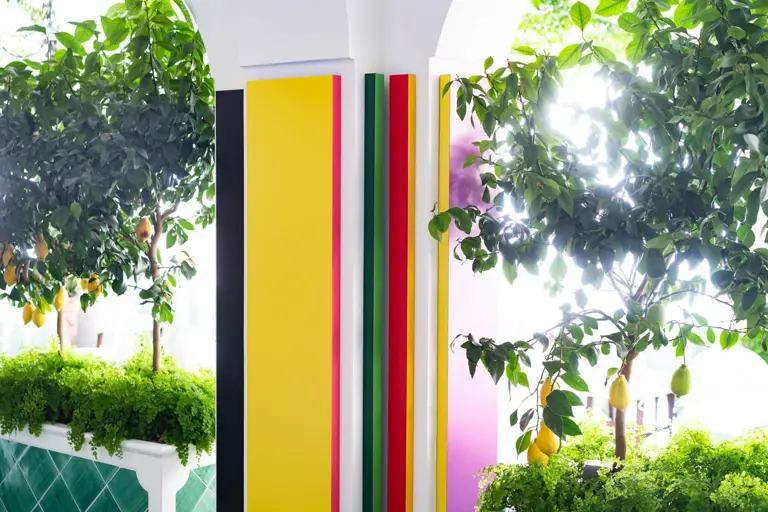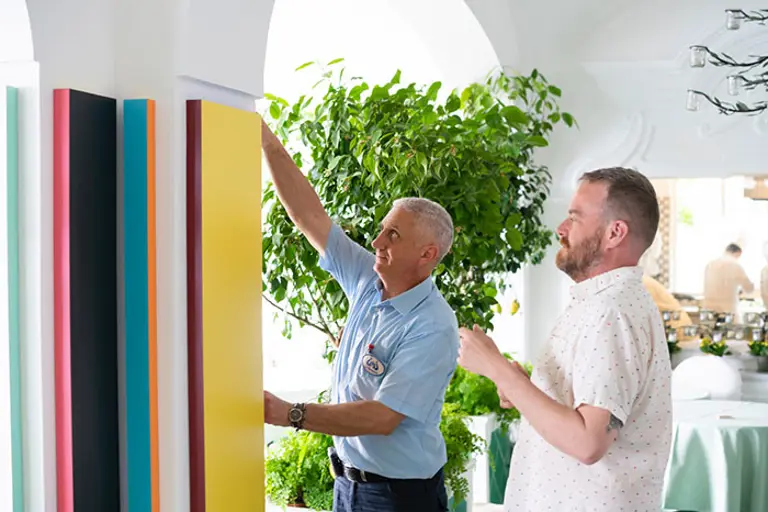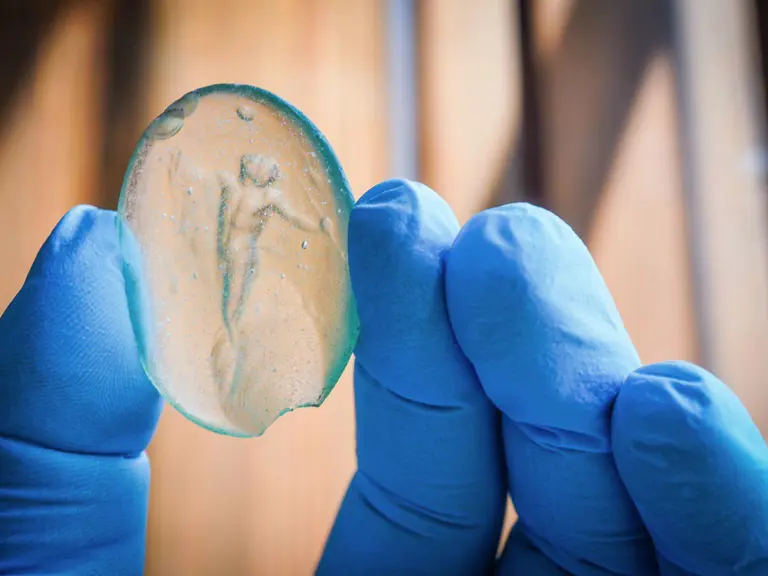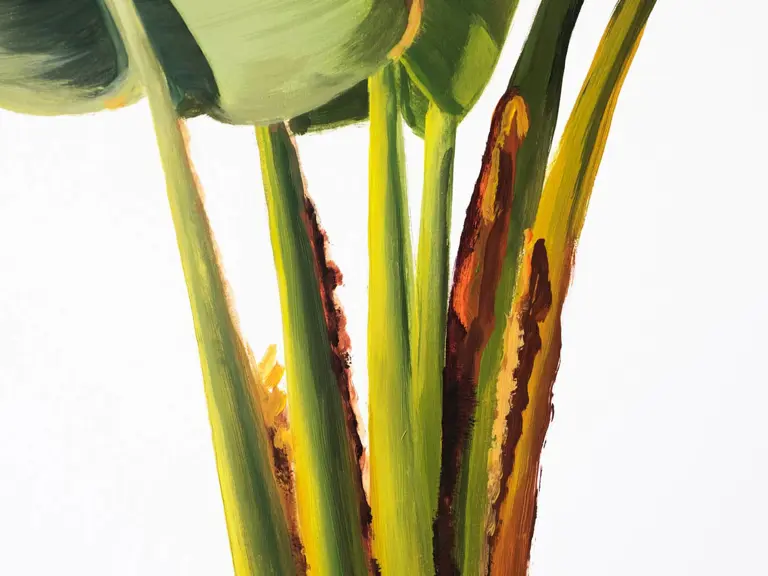MATT CONNORS: COLUMN CHROMATOGRAPHY
02.07.2018 ART & CULTURE
Chicago-born Connors has long eluded easy categorization. In his work, even the application of pigment to a flat support – a basic definition of the act of painting – is held up for scrutiny, not taken for granted.
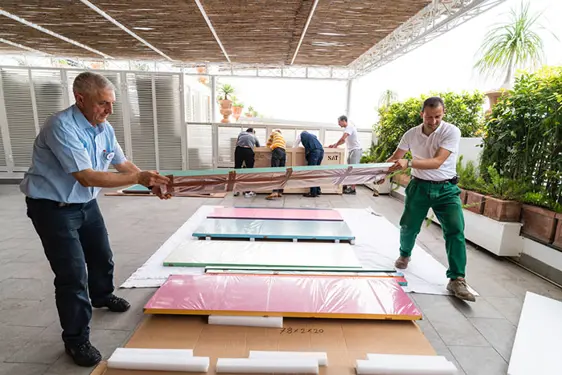
View
One way in which Connors achieves this is to take his ‘paintings’ off the walls; another is to consider the ‘canvas’ in all its three-dimensionality, to objectify it. A long-running strand of his work consists of reimagining the painterly support not as a flat surface with only one side but as a rectangular cuboid that can potentially offer all of itself to the artist’s ‘brush’.
Working closely with Antonio and Carla Sersale and Sirenuse Art Projects curator Silka Rittson-Thomas, Connors has devised a site-specific application of this aspect of his practice that plays engagingly with the traditional Amalfi architecture of a hotel that was once the Sersale family home.
The artist chose two of the hotel’s structural columns to clothe with polychrome laminate panels, each painted a different colour on its facing side and four edges. The first greets guests as soon as they walk into the lobby: here Connors installed four long panels, one on each side of the rectangular-section column, inviting us to engage in a game that is both vibrant and disciplined.
The ‘Continuous Color Circuit’ is almost Fauvist in its visual impact but deeply rationalist in the way it assigns one shade to each geometric plane. This soberly minimalist message is conveyed also by the panels’ smooth ‘industrial’ finish – carried out by a talented US art technician who has worked for such luminaries as Sol LeWitt and Haim Steinbach.
Downstairs, amidst the bougainvillea and lemon trees of the La Sponda restaurant, the game is still more complex. Here the chosen column has two perpendicular and two niched corners. In the countersunk facets of the latter, Connors inserted four long, narrow panels. Together with the exposed white parts of the columns, the play of edges, faces and hues creates an absorbing, mesmeric optical effect as one moves around the work.
After the March 2018 installation – an unusual challenge for Le Sirenuse’s regular maintenance team – Silka Rittson-Thomas sat down with the Sirenuse Journal and Matt Connors to talk about the artist’s practice and the ‘architectural’ strand in his work that is so dazzlingly displayed in this new commission.
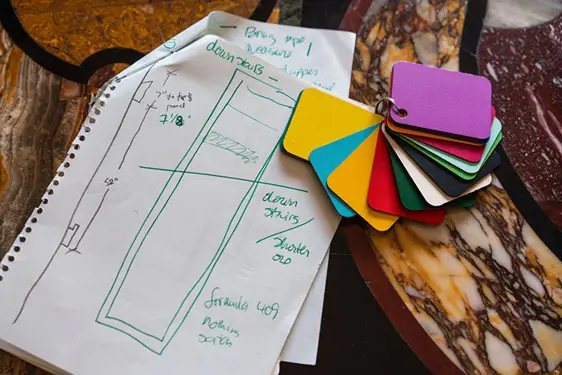
View
SRT: Can you describe how you started with these architectural paintings, these structures that have been an integral part of your practice from the very beginning?
MC: I have always thought of paintings/my paintings as objects (I’ve never really been very interested in creating any kind of illusionistic space in my paintings) and I often think of objects in terms of their function or lack of function, or maybe just how they engage with – or play with – the idea of function. Architecture and design have always been important influences for me. So at a certain point I decided to take the leap and move from suggestions of object-hood and function within the paintings to making actual objects/structures. I still consider them as paintings though.
SRT: What I love about these works is the different effect every single viewpoint produces. Each time you shift and walk around, it’s almost hard to memorize the colours one has just seen from the other angles.
MC: I really like this too - I often think that my favorite experience with artworks always begins with a bit of confusion, so I think this proliferation of possible views of this work allows for a lot of productive confusion. It allows for various ideas and memories of the work to exist at the same time, all the while in a pretty basic/minimalist form.
SRT: The works are made of wooden panels clad in the kind of industrial plastic laminate that we associate with domestic and commercial furniture, especially in kitchens and offices. Plastic laminate became an important material for a whole generation of post-war Italian designers, so there’s a kind of bridge between Italy and New York City in your work, a true collaborative spirit.
MC: Absolutely. Many of the radical Italian designers that I have loved for so long used laminate in a lot of their work, and even collaborated with Abet Laminati, the leading Italian producer of laminates.
SRT: The influence of Ettore Sottsass is clearly visible in your work. What does he mean to you?
MC: I was just looking at Sottsass’ travel photographs in old issues of the Italian design magazine Terrazzo, and thinking about how his incredible, global knowledge of design, architecture and decoration got boiled down into his own super unique touch. He’s definitely a big influence, and actually I think using the laminate material is a bit dangerous in the way it so closely flirts with this influence, so I have to take care to make it my own! I think with this project, the structure is so simple, but suddenly becomes very elaborate, almost Baroque, through the simple strategy of setting each panel back five centimeters from the edge of the columns, allowing all of the corners to multiply.
SRT: The Bauhaus School and Josef and Anni Albers are also references we keep talking about.
MC: Yes, Bauhaus and the Albers are big for me – they’re all about maximal effect from minimal gestures, true faith in colour and structure. Somehow I feel that the Bauhaus School and the Albers were almost romantic in their real belief in the power and essential importance of these things.

View
Matt Connors lives and works in New York. His solo exhibitions include Impressionism, MoMA PS1, New York (2012), two shows at London’s Herald St Gallery (Synthesizer, 2013 and Not Straight, 2015) with a third scheduled for 2019, and two shows at CANADA in New York (Machines, 2014 and Hocket, 2017). In 2012, he published the book A Bell is a Cup, which was awarded a Walter Tiemann Prize in 2014 for its innovative design.
Photos © Roberto Salomone
Le Sirenuse Newsletter
Stay up to date
Sign up to our newsletter for regular updates on Amalfi Coast stories, events, recipes and glorious sunsets
